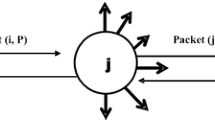Abstract
The cooperative multi-hop communication in a remote infrastructureless networking environment poses a serious security threat for the design of wireless sensor networks (WSNs). Because of their vulnerability to attacks, the intrinsic and demanding assignment of WSNs is security. Earlier security solutions aimed at thwarting different types of malicious threats but failed to consider the resource constrained nature of sensor nodes. The stringent resource constraints of WSNs require a lightweight trust-based routing scheme. In this paper, we propose a collaborative lightweight trust-based (CLT) routing protocol for WSNs with minimal overhead in regard to memory and energy consumption. It does not use promiscuous mode of operation to monitor the neighboring nodes for trust derivation. CLT employs a novel trust counselor that monitors and warns the neighboring nodes whose trust falls below a warning threshold. The warning message alarms a sensor node to check and correct the packet forwarding behavior to improve its trust relationship with its neighbors. Theoretical analysis and simulation results of CLT protocol demonstrate higher packet delivery ratio, higher network lifetime, lower end-to-end delay, lower memory and energy consumption than the traditional and existing trust-based routing schemes.






Similar content being viewed by others
References
Chen, X., Makki, K., Yen, K., & Pissinou, N. (2009). Sensor network security: A survey. IEEE Communications Surveys & Tutorials, 11(2), 52–73.
Wang, Y., Attebury, G., & Ramamurthy, B. (2006). A survey of security issues in wireless sensor networks. IEEE Communication Surveys and Tutorials, 8(2), 2–23.
Maarouf, I. K., & Naseer, A. R. (2007). WSNodeRater—An optimized reputation system framework for security aware energy efficient geographic routing in WSNs. In International conference on computer systems and applications, pp. 258–265.
Doddapaneni, K., Ever, E., Gemikonakli, O., Mostarda, L., & Navarra, A. (2012). Effects of IDSs on the WSNs lifetime: Evidence of the need of new approaches. In 11th international conference on trust, security and privacy in computing and communications, pp. 907–912.
Tanachaiwiwat, S., Dave, P., Bhindwale, R., & Helmy, A. (2004). Location-centric isolation of misbehavior and trust routing in energy-constrained sensor networks. In IEEE workshop on energy-efficient wireless communications and networks (EWCN) in conjunction with IEEE international conference on performance, computing and communications (IPCCC), Phoenix, AZ, pp. 463–469.
Perrig, A., Szewczyk, R., Wen, V., Culler, D., & Tygar, D. (2002). SPINS: Security protocols for sensor networks. Wireless Networks, 8(5), 521–534.
Srinivasan, A., & Wu, J. (2007). A novel k-parent flooding tree for secure and reliable broadcasting in sensor networks. In IEEE international conference on communications, pp. 1497–1502.
Srinivasan, A., & Wu, J. (2009). Secure and reliable broadcasting in wireless sensor networks using multi-parent trees. Security and Communication Networks, 2(3), 239–253.
Hu, J., Chen, H., & Gao, C. (2008). Agent-based trust management model for wireless sensor network. In 2nd international conference on multimedia and ubiquitous engineering (MUE 2008), pp. 150–154.
Li, F., Srinivasan, A., & Wu, J. (2008). A novel CDS-based reputation monitoring system for wireless sensor networks. In 28th international conference on distributed computing systems workshop, pp. 364–369.
Maarouf, I., Baroudi, U., & Naseer, A. (2009). Efficient monitoring approach for reputation system-based trust-aware routing in wireless sensor networks. IET Communications, 3(5), 846–858.
Ahmed, R., Jameel, H., d’Auriol., B. J., Lee, H., Lee, S., & Song, Y.-J. (2009). Group-based trust management scheme for clustered wireless sensor networks. IEEE Transactions on Parallel and Distributed Systems, 20(11), 1698–1712.
Zhan, G., & Shi, W. (2012). Design and implementation of TARF: A trust-aware routing framework for WSNs. IEEE Transactions on Dependable and Secure Computing, 9(2), 184–197.
He, D., Chen, C., Chan, S., Bu, J., & Vasilakos, A. V. (2012). ReTrust: Attack-resistant and lightweight trust management for medical sensor networks. IEEE Transactions on Information Technology in Biomedical, 16(4), 623–632.
Bao, F., Chen, I.-R., Chan, M., & Cho, J.-H. (2012). Hierarchical trust management for wireless sensor networks and its applications to trust-based routing and intrusion detection. IEEE Transactions on Network and Service Management, 9(2), 169–183.
Zhang, J., Shankaran, R., Orgun, M. A., Varadharajan, V., & Sattar, A. (2010). A trust management architecture for hierarchical wireless sensor networks. In 35th annual IEEE conference on local computer networks, pp. 264–267.
Rahhal, H. A., Ali, I. A., & Shaheen, S. I. (2011). A novel trust-based cross-layer model for wireless sensor networks. In 28th national radio science conference, C5, pp. 1–10.
Li, X., Zhou, F., & Du, J. (2013). LDTS: A lightweight and dependable trust system for clustered wireless sensor networks. IEEE Transactions on Information Forensic and Security, 8(6), 924–935.
Anita, X., Martin Leo Manickam, J., & Bhagyaveni, M. A. (2013). Two-way acknowledgment-based trust framework for wireless sensor network. In International Journal of Distributed Sensor Networks, Article ID 952905.
Rumsey, D. J. (2011). Statistics for dummies (2nd ed.). London: Wiley.
Zhu, S., Setia, S., & Jajodia, S. (2003). LEAP: Efficient security mechanisms for large-scale distributed sensor networks. In Proceedings of 10th ACM conference on computer and communication security (CCS ’03), pp. 62–72.
Chan, H., Perrig, A., & Song, D. (2003). Random key predistribution schemes for sensor networks. In Proceedings of IEEE symposium on security and privacy, pp. 197–213.
Karlof, C., Sastry, N., & Wagner, D. (2004). TinySec: A link layer security architecture for wireless sensor networks. In Proceedings of second international conference on embedded networked sensor systems (SenSys ’04), pp. 162–175.
Perkin, C. E., & Royer, E. M. (1999). Ad hoc on demand distance vector routing. In Second IEEE workshop on mobile computing, systems and applications, pp. 90–100.
Chen, J., Du, X., & Fang, B. (2012). An efficient anonymous communication protocol for wireless sensor networks. Wireless Communication & Mobile Computing, 12(14), 1302–1312.
Author information
Authors and Affiliations
Corresponding author
Rights and permissions
About this article
Cite this article
Anita, X., Bhagyaveni, M.A. & Martin Leo Manickam, J. Collaborative Lightweight Trust Management Scheme for Wireless Sensor Networks. Wireless Pers Commun 80, 117–140 (2015). https://doi.org/10.1007/s11277-014-1998-2
Published:
Issue Date:
DOI: https://doi.org/10.1007/s11277-014-1998-2




